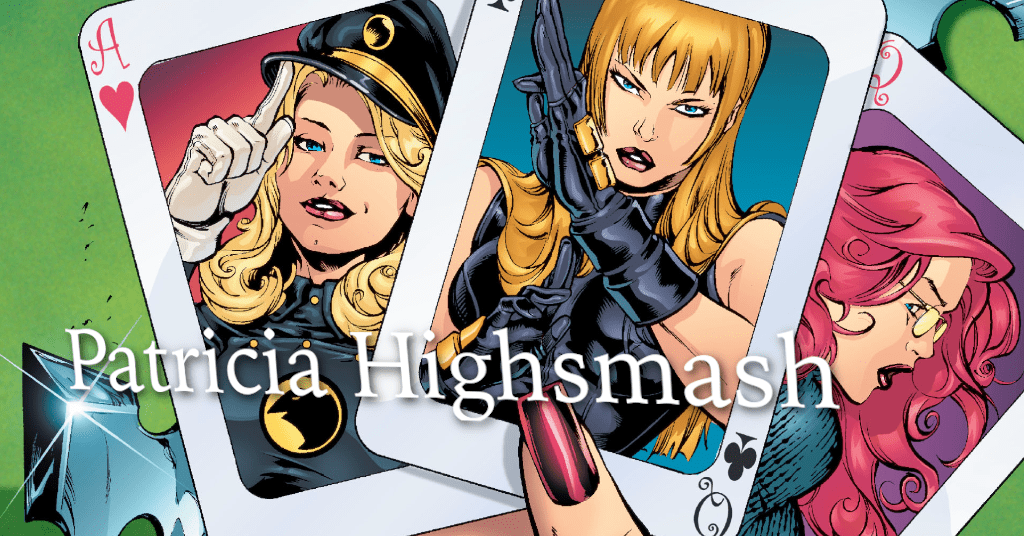Patricia Highsmash
Gail Simone’s Birds of Prey Feels Like a Promise
by Travis Hedge Coke
Gail Simone’s Birds of Prey feels like a promise, but it would be a promise I have made up in my head.
Just under seventy issues in cumulative length, and frustratingly not yet collected into any kind of comprehensive omnibus, Simone’s run on Birds of Prey really feels to me as if it lasts one hundred issues or more. It is broken by smaller runs by others, and it did not begin the title, but it is, for me, the canon. It is the run I return to, both to read and to remember. Gail Simone’s Birds of Prey lives in my memory, fresh as anything.
Every panel feels welcoming to me, every page feels human. I am not always enthused with the art, and for that reason it feels, explicit, to me that what I am drawn in by is Simone’s contribution. This does not mean the pencilers, inkers, colorists and letterers, the editors and group editors do not do their part or are in any way lesser or pro forma; I am not necessarily there for them. (And, some of the artists draw Barda too skinny.) I am there for the illusion of realness, of intimacy and verve that makes a comic I can enjoy as fiction but also pretend, momentarily, has truth. I am here for the characterization, the pacing, the humor and pathos and drama and fire.
I am there for the artists, too, of course. I forget. Nicola Scott, in particular, is so damn good, I forget. What do you mean those were not real events I saw live and on replay? She drew? What? Are you sure?
Everyone feels like a whole person. Everyone feels like a real character. They have definite and vibrant personality. They have hungers and temperatures and passions and fears and debts and toenails.
Jordan B Gorfinkel arranged for the Birds of Prey title and concept to exist, utilizing characters created by others before him, but Simone breathed life. Not alone, but a lot.
Early issues use food and scenes of dining to bring us close to the characters, to let us taste from their mouths and feel their loneliness. Birds of Prey is a constellation of lonely people and that is how it makes us feel less lonely. Something that makes BoP a comfort read is that the characters need to reach out, themselves, and do not always know how to do so.
When Barbara Gordon reveals to her father, Commissioner James Gordon, that she formerly was the local superheroine, Batgirl, and is currently the global intelligence powerhouse, Oracle, her dad already knows. Not everything. But, he knows.
A recurrent theme is that the secrets we work the hardest to preserve as less secret that we assume and that what seem to be the least significant fumbles to us can really and truly hurt someone else. When Huntress makes a joke about the sexual stamina of fellow superhero, Arsenal, she cannot know that she is making the joke to someone who thinks of Arsenal as somewhere between a little brother and a son, or that, by tying it to archers in general, she is bringing up an entire mess, but there she is, making the joke to Black Canary days after she and archer and superhero, Green Arrow, have broken up.
Organized crime, international espionage, medical drama, supervillain shenanigans, feuding martial arts schools, sex, fights, family, honor debts and friendship are handed briskly without ever losing weight. The run kept two or three generations of preexisting superheroes afloat in webs of intrigue and costumed battles, but also introduced an entire generation of its own with Misfit and Black Alice, Renee and Sin. Kids – teenagers, preteens, babies, adult children – are omnipresent as they are in real life.
Oracle and Black Canary have family. They have elder family and younger. Huntress, an orphan, has extant family and family debt, family legacy and history and guilt. To be alive is to be a sister, an aunt, a friend, an enemy, a daughter. To know people. To be a person is to have connections and the potential, always, for other connections.
As the comic expands, taking the cast to Metropolis, across the world and then across America, to embrace the New Gods, drawing in the big gun heroes of the Justice League, the elders of the Justice Society, a time-displaced Black Hawk, Birds of Prey transforms from a Batman satellite to a microcosm of the DC Universe. The heart of the DC Universe.
Magic! Aliens! Vigilantes! Martial arts schools and spy cabals!
And, they all definitely live and fight and work and laugh and eat dinners in the same universe. It feels cohesive, it feels livable. A livable DC Universe. Gail Simone’s DC Universe.
In Gail Simone’s DC Universe, Misfit can be “the damn Batgirl” and announce her “dark vengeance,” and she can be a confused, overeager kid in need of mentorship and direction. And, in Simone’s DC Universe Talia al Ghul can be sucker punched, Batman can read the room enough to keep his mouth shut, Blue Beetle can be grieved with jokes about cybersex, and Shiva can show an entire range of human emotion. And, Junior can drop in from a completely different comic, and murder somebody. Because Junior is the goddamn terror.
